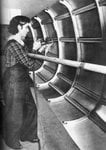I have read several brief mentions that the Hurricane was less expensive than the Spitfire.
Was it just that Supermarine charged more or was the airframe really that much more complicated to produce? The Hurricane seems more complicated with the cloth covered parts as compared to the all-metal fuselage of the Spitfire.
The cost of the engines could not be a factor nor could initial armament (8 .303 Brownings) but yet it appears that Hurricane were more plentiful in the early years because the cost of the Spit was a factor.
Was Supermarine just making more of a profit?
Was it just that Supermarine charged more or was the airframe really that much more complicated to produce? The Hurricane seems more complicated with the cloth covered parts as compared to the all-metal fuselage of the Spitfire.
The cost of the engines could not be a factor nor could initial armament (8 .303 Brownings) but yet it appears that Hurricane were more plentiful in the early years because the cost of the Spit was a factor.
Was Supermarine just making more of a profit?

